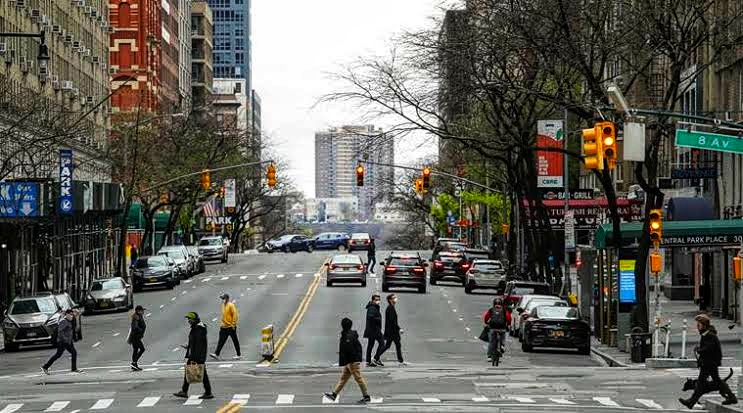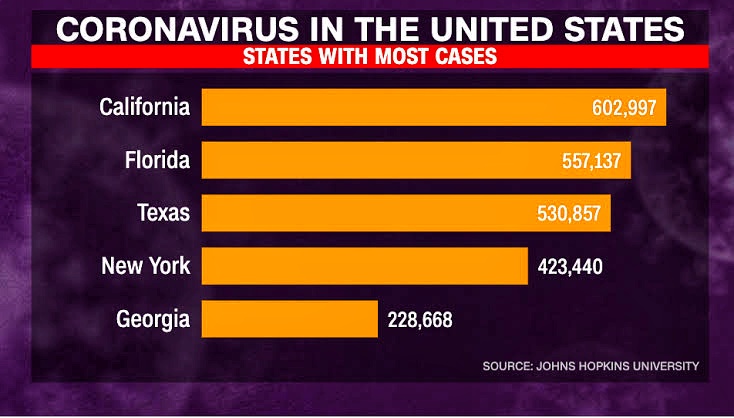California becomes first state to pass 600,000 coronavirus cases
 |
| California counties that will remain on the state’s watch list a designation that requires areas to impose more severe restrictions on businesses and activities to slow the spread of the coronavirus |
California has become the first state in the nation to surpass 600,000 confirmed coronavirus cases.
As of Friday morning, there were more than 603,000 recorded cases. The state also has now reported more than 11,000 deaths.
Yet despite the grim numbers, there is growing evidence that the surge in infections and fatalities that began when California reopened its economy in May is beginning to slow.
In Los Angeles County, the effective transmission rate of the coronavirus is now about 0.86 meaning that every one infected person passes the virus to an average of 0.86 other people. Last week, the rate was at 0.91.
And statewide, an ensemble computer model known as the California COVID Assessment Tool estimates California’s overall transmission rate is about 0.96.
When asked about the 600,000-case milestone during a news briefing Friday, Gov. Gavin Newsom said he and his administration are more concerned with the state’s positivity rate the proportion of people who test positive for the virus of all who have been tested which currently sits at about 6.2%.
“That gives us a better sense of what’s really happening in terms of the community spread,” he said.
Newsom acknowledged that California’s efforts to ramp up its COVID-19 testing capabilities will logically increase the number of new infections that are uncovered. Over the past week, the state has conducted an average of about 137,000 daily tests, he said.
But, he added, “we’re not shying away from that; we’re not playing to the political frame that somehow tests are bad because they will, by definition, show a higher count of total number of positives.”
“This nation, I think, deserves to have a better sense to know, ‘How prevalent is this disease?’” he said. “And I can assure you … it’s significantly, I would argue, more prevalent than those numbers, even in California, suggest. And it’s simply because we haven’t put the testing protocols in place and we haven’t scaled our testing capacity as the most innovative nation on the planet. That includes California. We’ve got work to do.”
Hospitalizations are also falling in many regions of California. Statewide, the average number of people who were hospitalized seemed to peak in late July, when an average of nearly 7,000 people were in hospitals with confirmed coronavirus infections over a seven-day period; by Wednesday, that number had fallen to 5,710.
“While our gains might feel slow and our future remains fragile, our success over the last three weeks is real,” Los Angeles Mayor Eric Garcetti said Wednesday. “We begin to see signs of light.”
 |
| As of Friday morning, there were more than 603,000 recorded cases. The state also has now reported more than 11,000 deaths |
Newsom said Friday that the latest data show 5,189 COVID-19 patients were hospitalized statewide an almost 20% decrease over the last 14 days.
He also announced that the state had confirmed 7,934 new infections on Thursday. However, 4,429 of those were the result of a backlog caused by data failures with the CalREDIE electronic system, which collects information from laboratories and feeds it to state and local health departments.
While reconciling that logjam has warped the state’s daily reporting data throughout the week, Newsom promised that all errors in state coronavirus testing data will be resolved by Monday.
Last week, the state acknowledged that up to 300,000 records had not been processed by the computer database used to provide local health officials with COVID-19 test results. The failure has hampered efforts to understand the spread of the coronavirus.
Once all of that data are processed, Newsom said he will update the California counties that will remain on the state’s watch list a designation that requires areas to impose more severe restrictions on businesses and activities to slow the spread of the coronavirus.
“On Monday, we’re going to break down by county a detailed list so people will have, with clarity and precision, every single number,” he said.
As America’s most populous state, California was viewed early on as a model in the battle against COVID-19. But the summer spike has instead made the state a cautionary tale.
A week ago, the state recorded 10,000 deaths. By Friday, that number had increased 10%. The weekly death toll is nearly double what it was in April, when the first wave of coronavirus cases and fatalities were peaking.
Still, at 11,000 deaths, California remains well below New York one of the earliest hot spots for the virus which has recorded more than 30,000 fatalities.
Los Angeles County has tallied the bulk of the coronavirus cases and deaths in California, accounting more than one-third of the overall cases and nearly half of all deaths. On Thursday, public health officials reported 64 new deaths and 1,999 additional cases.
Public health director Barbara Ferrer said Wednesday that the rate of disease is still too high for colleges and universities to allow in-person instruction, with limited exceptions such as lab work or arrangements for students who will become part of the essential workforce.
“The very nature of the way that colleges and universities operate creates a significant risk of outbreaks of COVID-19,” Ferrer said.
